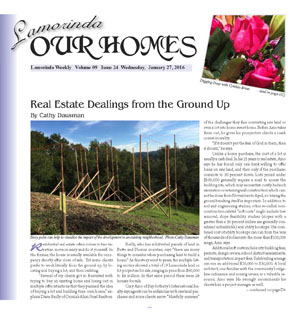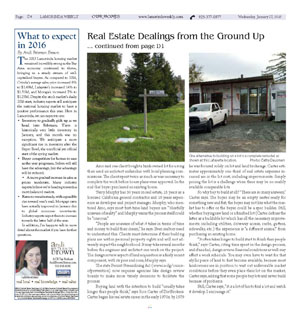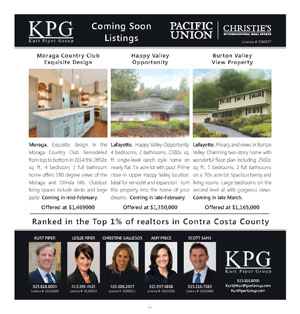|
|
Published January 27, 2016
|
Real Estate Dealings from the Ground Up
|
|
| By Cathy Dausman |
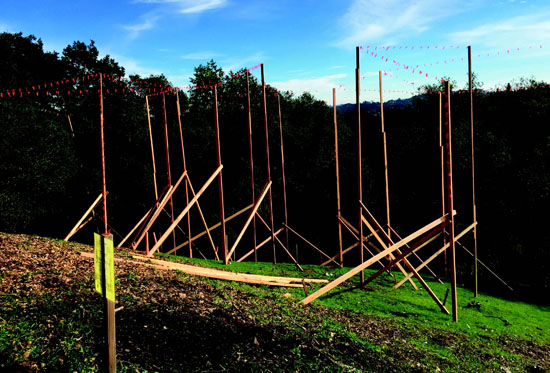 |
| Story poles can help to visualize the impact of the development in an existing neighborhood Photo Cathy Dausman |
Residential real estate often comes in two varieties: move-in ready and do-it-yourself. In the former, the house is usually available for occupancy shortly after close of sale. Yet some clients prefer to work literally from the ground up, by locating and buying a lot, and then building.
 "Several of my clients got so frustrated with trying to buy an existing home and losing out in multiple offer situations that they pursued the idea of buying a lot and building their own home," explains Diane Reilly of Orinda's Alain Pinel Realtors.
"Several of my clients got so frustrated with trying to buy an existing home and losing out in multiple offer situations that they pursued the idea of buying a lot and building their own home," explains Diane Reilly of Orinda's Alain Pinel Realtors.
 Reilly, who has subdivided parcels of land in Butte and Plumas counties, says "there are many things to consider when purchasing land to build a home." As this story went to press, the multiple listing service showed a total of 19 Lamorinda land or lot properties for sale, ranging in price from $90,000 to $4 million. In that same period there were 28 houses for sale.
Reilly, who has subdivided parcels of land in Butte and Plumas counties, says "there are many things to consider when purchasing land to build a home." As this story went to press, the multiple listing service showed a total of 19 Lamorinda land or lot properties for sale, ranging in price from $90,000 to $4 million. In that same period there were 28 houses for sale.
 Cary Amo of Bay Sotheby's International Realty says agents can be unfamiliar with raw land purchases and some clients arrive "blissfully unaware" of the challenges they face converting raw land or even a lot into home sweet home. Before Amo takes them out, he gives his prospective clients a crash course in reality.
Cary Amo of Bay Sotheby's International Realty says agents can be unfamiliar with raw land purchases and some clients arrive "blissfully unaware" of the challenges they face converting raw land or even a lot into home sweet home. Before Amo takes them out, he gives his prospective clients a crash course in reality.
 "If it doesn't put the fear of God in them, then it should," he says.
"If it doesn't put the fear of God in them, then it should," he says.
 Unlike a home purchase, the cost of a lot is usually a cash deal. In his 25 years in real estate, Amo says he has found only one bank willing to offer loans on raw land, and then only if the purchaser commits to 30 percent down. Lots priced under $500,000 generally require a road to access the building site, which may necessitate costly bedrock excavation or retaining wall construction which cannot be done from November to April, so timing the groundbreaking itself is important. In addition to soil and engineering studies, other so-called non-construction related "soft costs" might include tree removal, slope feasibility studies (slopes with a greater than a 30 percent incline are generally considered unbuildable) and utility hookups. The combined cost of utility hookups can run from the tens of thousands of dollars into the more than $100,000 range, Amo says.
Unlike a home purchase, the cost of a lot is usually a cash deal. In his 25 years in real estate, Amo says he has found only one bank willing to offer loans on raw land, and then only if the purchaser commits to 30 percent down. Lots priced under $500,000 generally require a road to access the building site, which may necessitate costly bedrock excavation or retaining wall construction which cannot be done from November to April, so timing the groundbreaking itself is important. In addition to soil and engineering studies, other so-called non-construction related "soft costs" might include tree removal, slope feasibility studies (slopes with a greater than a 30 percent incline are generally considered unbuildable) and utility hookups. The combined cost of utility hookups can run from the tens of thousands of dollars into the more than $100,000 range, Amo says.
 Additional soft costs include city building fees, permits, design review, school district assessments, and transportation impact fees. Subdividing acreage can run an additional $20,000 to $30,000. A local architect, one familiar with the community's ridgeline ordinance and zoning issues, is a valuable resource, Amo says. He strongly recommends his clients hire a project manager as well.
Additional soft costs include city building fees, permits, design review, school district assessments, and transportation impact fees. Subdividing acreage can run an additional $20,000 to $30,000. A local architect, one familiar with the community's ridgeline ordinance and zoning issues, is a valuable resource, Amo says. He strongly recommends his clients hire a project manager as well.
 Amo said one client bought a bank-owned lot for a song then used an architect unfamiliar with local planning commissions. The client spent twice as much as was necessary to complete the work before house plans were approved. In the end that buyer purchased an existing home.
Amo said one client bought a bank-owned lot for a song then used an architect unfamiliar with local planning commissions. The client spent twice as much as was necessary to complete the work before house plans were approved. In the end that buyer purchased an existing home.
 Terry Murphy has 30 years in real estate, 25 years as a licensed California general contractor and 16 years experience as developer and project manager. Murphy, who mentored Amo, says most first-time land buyers are "blissfully unaware of reality" and Murphy warns the process itself could be "onerous."
Terry Murphy has 30 years in real estate, 25 years as a licensed California general contractor and 16 years experience as developer and project manager. Murphy, who mentored Amo, says most first-time land buyers are "blissfully unaware of reality" and Murphy warns the process itself could be "onerous."
 "People are unaware of what it takes in terms of time and money to build their dream," he says. Even realtors need to understand this. Clients must determine if their building plans are within personal property rights and will not adversely impact the neighborhood. It may take several months before the engineer and architect can work on the project. The design review aspect of land acquisition is a fairly recent component, with its pros and cons, Murphy says.
"People are unaware of what it takes in terms of time and money to build their dream," he says. Even realtors need to understand this. Clients must determine if their building plans are within personal property rights and will not adversely impact the neighborhood. It may take several months before the engineer and architect can work on the project. The design review aspect of land acquisition is a fairly recent component, with its pros and cons, Murphy says.
 The state Permit Streamlining Act (www.ca-ilg/ounceofprevention) now requires agencies like design review boards to make more timely decisions to facilitate the process.
The state Permit Streamlining Act (www.ca-ilg/ounceofprevention) now requires agencies like design review boards to make more timely decisions to facilitate the process.
 Buying land with the intention to build "usually takes longer than people think," says Ron Carter of DirtBrokers. Carter began his real estate career in the early 1970s; by 1979 he was focused solely on lot and land brokerage. Carter estimates approximately one-third of real estate expenses incurred are in the lot cost, including improvements. Simply pricing the lot is a challenge when there may be no readily available comparable lots.
Buying land with the intention to build "usually takes longer than people think," says Ron Carter of DirtBrokers. Carter began his real estate career in the early 1970s; by 1979 he was focused solely on lot and land brokerage. Carter estimates approximately one-third of real estate expenses incurred are in the lot cost, including improvements. Simply pricing the lot is a challenge when there may be no readily available comparable lots.
 So why buy to build at all? "There are so many answers," Carter says. The buyer may be an empty nester ready for something new and flat; the buyer may not like what the market has to offer or the buyer could be a spec builder. Still, whether buying raw land or a finished lot (Carter defines the latter as a buildable lot which has all the necessary improvements, including utilities, driveway access, curbs, gutters, sidewalks, etc.) the experience is "a different animal" from purchasing an existing home.
So why buy to build at all? "There are so many answers," Carter says. The buyer may be an empty nester ready for something new and flat; the buyer may not like what the market has to offer or the buyer could be a spec builder. Still, whether buying raw land or a finished lot (Carter defines the latter as a buildable lot which has all the necessary improvements, including utilities, driveway access, curbs, gutters, sidewalks, etc.) the experience is "a different animal" from purchasing an existing home.
 "It often takes longer to build start to finish than people think," says Carter, citing time spent in the design process, and if needed, design review. Seasonal conditions as well may affect a work schedule. You may even have to wait for that idyllic piece of land to first become available, because most landowners are in position to wait out unfavorable market conditions before they even place their lot on the market, Carter says, adding that some people buy lots and never build because of problems.
"It often takes longer to build start to finish than people think," says Carter, citing time spent in the design process, and if needed, design review. Seasonal conditions as well may affect a work schedule. You may even have to wait for that idyllic piece of land to first become available, because most landowners are in position to wait out unfavorable market conditions before they even place their lot on the market, Carter says, adding that some people buy lots and never build because of problems.
 Still, Carter says, "it is a lot of fun to find a lot and watch it develop. I encourage it."
Still, Carter says, "it is a lot of fun to find a lot and watch it develop. I encourage it."

|
 |
| |
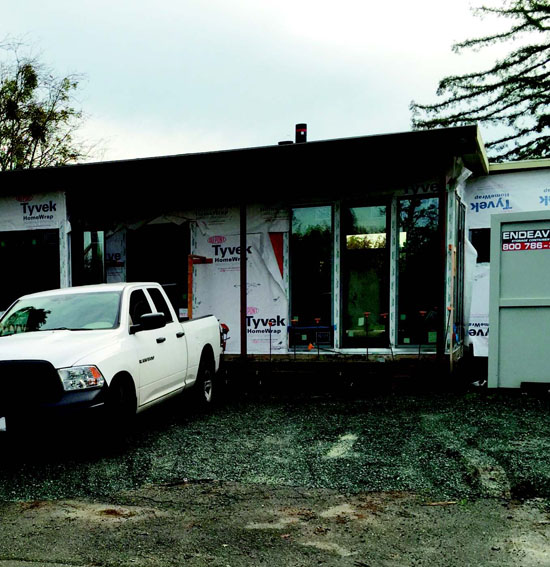 |
| One alternative to building on a lot is a complete remodel, as shown at this Lafayette location. Photos Cathy Dausman |
|
|
|
|
| |
|
|
|
|





